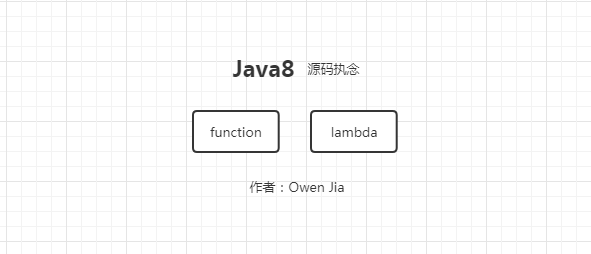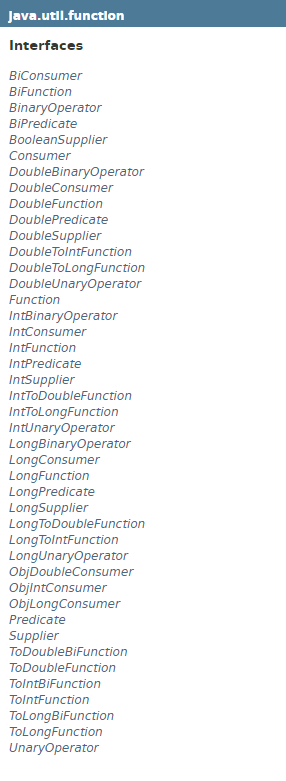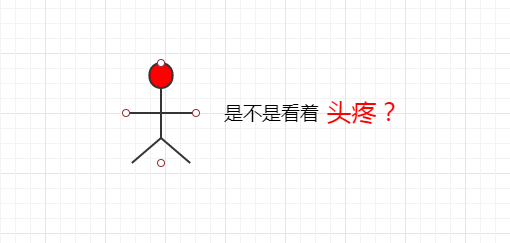继续java8新亮点的源码之路,functional interface是一个跳不过的坎,它与lambda的结合使用非常普遍。java.util.function包对于每一个java工程师来说是必备技能,也是最基础的能力,一定要掌握。

函数编程的最直接的表现在于将函数作为数据自由传递,结合泛型推导能力使代码表达能力获得飞一般的提升。同时Lambda表达式让你能够将函数作为方法参数或者将代码作为数据对待,让你发现“行级代码”优美。
java8引入新的注解,@FunctionalInterface
函数式注解@FunctionalInterface添加在一个接口上,主要是编译器检查提示作用。
- 注解的作用是检测自定义functional接口是否符合要求,编译器会有错误提示;
- 一个接口符合functional的要求,不加这个注解也可以正常使用,建议都加上;
- 有且只能有一个抽象方法但可以有多个非抽象方法,简单说就是接口里面default和static的方法是可以有多个的,其他的方法只能有一个。
lambda表达式写法及注意点
格式:
( parameters ) -> { statements; }。
- 不需要声明参数类型,编译器可以识别参数值;
- 单个参数和语句下,圆括弧和大括弧可以省略;
- 表达式是一个闭包,定义了行内执行的方法类型接口;
- 只能引用标记了final的外层局部变量,不能在表达式内部修改定义在域外的局部变量,否则会编译错误;
- 表达式当中不允许声明一个与局部变量同名的参数或者局部变量;
写法示例:
@FunctionalInterface
public interface IPerson {
String say(String input);
//void stand(); 只能有一个抽象方法,不然编译无法默认识别调用
static void run(String xx){
PrintUtil.printTest("IPerson run : " + xx);
}
static void walk(){
PrintUtil.printTest("IPerson walk");
}
default void eat(int a, int b){
PrintUtil.printTest("IPerson eat : " + a + " - " + b);
}
}
//当你这种写法是编译器会提示你用lambda
IPerson person = new IPerson() {
@Override
public String say(String input) {
return "My said is " + input;
}
};
PrintUtil.printTest(person.say("i love china."));
//lambda写法
IPerson person2 = a -> "My said is " +a;
PrintUtil.printTest(person2.say("i love china."));
//结果是一样的,My said is i love china.
function包中重要接口源码分析

Consumer,接收一个输入参数T类型并不没有返回值;andThen看源码可以知道是添加一个其后执行的Consumer对象。
这个接口很简单不需要什么解释,看源码一眼OK。
@FunctionalInterface
public interface Consumer<T> {
void accept(T t);
default Consumer<T> andThen(Consumer<? super T> after) {
Objects.requireNonNull(after);
return (T t) -> { accept(t); after.accept(t); };
}
}
Function,接收一个T类型参数,返回一个R类型的结果。需要注意的是compose\andThen的传入参数和范围参数规则不同,这里的参数类型稍有不慎就会出错,复杂的链路里面排查bug是非常麻烦的事。
@FunctionalInterface
public interface Function<T, R> {
R apply(T t);
//生成了function的参数类型同before一样
default <V> Function<V, R> compose(Function<? super V, ? extends T> before) {
Objects.requireNonNull(before);
return (V v) -> apply(before.apply(v));
}
//新生成的function的返回值类型要after一样
default <V> Function<T, V> andThen(Function<? super R, ? extends V> after) {
Objects.requireNonNull(after);
return (T t) -> after.apply(apply(t));
}
//
static <T> Function<T, T> identity() {
return t -> t;
}
}
测试用例:
Function<Integer,String> function = a -> "== " + a;
PrintUtil.printTest(function.apply(101));
Function<String,Boolean> function1 = c -> c.length()>2;
PrintUtil.printTest(function1.apply("1a"));
PrintUtil.printTest(function.andThen(function1).apply(111));
//andThen类似consumer,是前一个function执行后结果作为参数传新生成的function执行,结构:true
Function<Integer,Integer> function2 = c -> c*c;
//compose和andThen正好逻辑相反,传入的参数function先执行后范围结果作为参数传给新生成的function执行
PrintUtil.printTest(function.compose(function2).apply(2));
//先执行function2,返回结果作为参数再执行function,结果:== 4
PrintUtil.printTest(function.compose(function2).andThen(function1).apply(2));
//先执行function2,其次执行funciton,最后执行function1,结果:true
PrintUtil.printTest(function2.compose(function2).apply(2));
//先执行第二个function2,返回结果作为参数再执行第一个function2,结果:16
//递归的实现又多了种办法
Function<String,String> function3 = Function.identity();//static方法
PrintUtil.printTest(function3.apply("hello"));
//identity定义了一个只返回输入参数的function,结果:hello

Predicate,是一个条件判断接口,接收一个T参数范围boolean值,默认抽象方法test(t);and\or\negate分别对应逻辑与、或、非操作,isEqual。
@FunctionalInterface
public interface Predicate<T> {
boolean test(T t);
//逻辑与
default Predicate<T> and(Predicate<? super T> other) {
Objects.requireNonNull(other);
return (t) -> test(t) && other.test(t);
}
//获取该对象否定的Predicate,相当于逆转boolean
default Predicate<T> negate() {
return (t) -> !test(t);
}
//逻辑或
default Predicate<T> or(Predicate<? super T> other) {
Objects.requireNonNull(other);
return (t) -> test(t) || other.test(t);
}
//生成一个判断对象是否相等的Predicate
static <T> Predicate<T> isEqual(Object targetRef) {
return (null == targetRef)
? Objects::isNull
: object -> targetRef.equals(object);
}
}
测试用例:
Predicate<ICar> carHas4Wheel = a -> a.getWheelCount() > 3;
ICar weilai = new WeiLaiCar(3);
PrintUtil.printTest(carHas4Wheel.test(weilai));
//false
PrintUtil.printTest(carHas4Wheel.negate().test(weilai));
//true
PrintUtil.printTest(carHas4Wheel.and(b -> b.getWheelCount()>2).test(weilai));
//false
PrintUtil.printTest(carHas4Wheel.and(b -> b.getWheelCount()>2).test(new WeiLaiCar(4)));
//true
PrintUtil.printTest(carHas4Wheel.or(b -> b.getWheelCount()>2).test(new WeiLaiCar(3)));
//true
PrintUtil.printTest(Predicate.isEqual(weilai).test(weilai));
//true
PrintUtil.printTest(Predicate.isEqual(weilai).test(new WeiLaiCar(3)));
//false
Supplier,是一个只有返回没有参数的接口,只有一个方法get。
@FunctionalInterface
public interface Supplier<T> {
/**
* Gets a result.
* @return a result
*/
T get();
}
测试用例:
Supplier<Integer> supplier = () -> 1 ;
PrintUtil.printTest(supplier.get());
//1
Supplier<ICar> carSupplier = () -> new WeiLaiCar(5) ;
PrintUtil.printTest(carSupplier.get() + " : " + carSupplier.get().getWheelCount());
//com.ts.util.optional.WeiLaiCar@32a1bec0 : 5

Consumer<T> Predicate<T> Supplier<T> Function<T, R> BiFunction<T, U, V>,这里的T U R V并没有特别的定义只是一种约定,就像驼峰命名和泛型中K V E一样。
分享连接
除了介绍的几种函数式接口外,java8在这几个基础上封装了很多的延伸接口,如BiConsumer\ DoubleConsumer\ IntConsumer\ LongConsumer\ ObjIntConsumer等。平时写代码时注意积累,闲的时候多去看看API,慢慢的就掌握了。
Lambda和Functional的结合很大一点就是代码简洁了,看着非常的赏心悦目。JAVA一个纯面向对象的语言,在行级代码上一直是非常的简洁易于调试,而这两个新特性的出现让行级代码的复杂度急剧提升。
相关用例代码已托管Github:play-java-sample。
推荐关注
作者:Owen Jia。
推荐关注他的博客:Owen Blog。